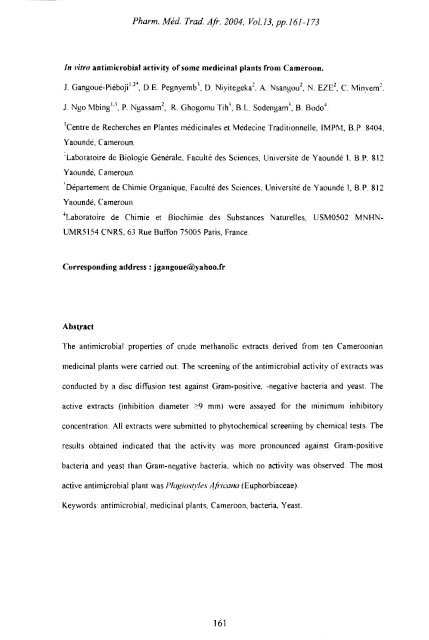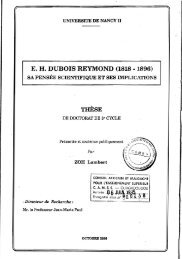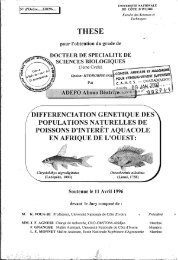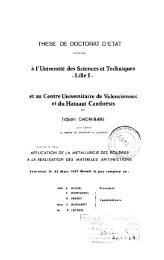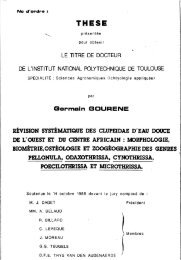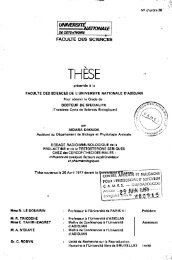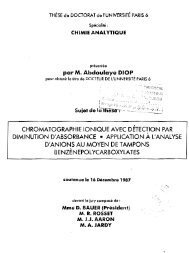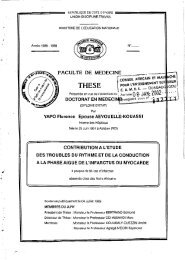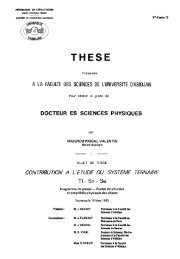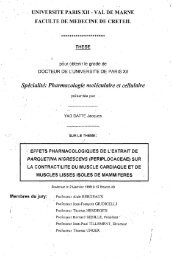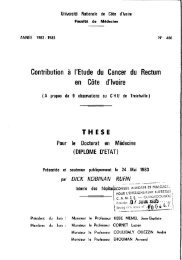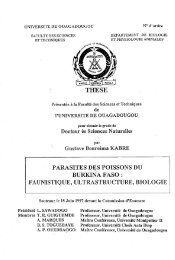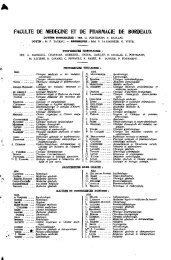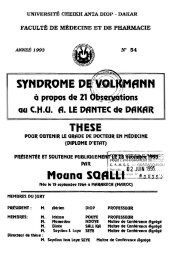In vitro antimicrobial activity of some medicinal plants from. Cameroon.
In vitro antimicrobial activity of some medicinal plants from. Cameroon.
In vitro antimicrobial activity of some medicinal plants from. Cameroon.
You also want an ePaper? Increase the reach of your titles
YUMPU automatically turns print PDFs into web optimized ePapers that Google loves.
Pharm. Méd. Trad. Afr. 2004, Vol. 13,pp.161-173<br />
ln <strong>vitro</strong> <strong>antimicrobial</strong> <strong>activity</strong> <strong>of</strong> sorne <strong>medicinal</strong> <strong>plants</strong> <strong>from</strong> <strong>Cameroon</strong>.<br />
1. Gangoué-Piéboji':", O.E. Pegnyernb', 0 Niyitegeka. A. Nsangou', N. EZE 2 • C. Minvem 2 .<br />
1. Ngo Mbing':', P. Ngassam, R. Ghogomu Tih', B.L. Sodengam', B. Bodo".<br />
'Centre de Recherches en Plantes médicinales et Medecine Traditionnelle, IMPM, B.P 8404,<br />
Yaoundé, Cameroun.<br />
.Laboratoire de Biologie Générale. Faculté des Sciences, Université de Yaoundé 1. B P. 812<br />
Yaoundé, Cameroun.<br />
'Département de Chimie Organique, Faculté des Sciences, Université de Yaoundé 1, B.P. 812<br />
Yaoundé, Cameroun<br />
"Laboratoire de Chimie et Biochimie des Substances Naturelles, USM0502 MNHN<br />
UMR5J54 CNRS. 63 Rue Buffon 75005 Paris, France<br />
Corresponding address : jgangoueéàyahoo.fr<br />
Abstract<br />
The <strong>antimicrobial</strong> properties <strong>of</strong> crude methanolic extracts derived <strong>from</strong> ten <strong>Cameroon</strong>ian<br />
<strong>medicinal</strong> <strong>plants</strong> were carried out. The screening <strong>of</strong> the <strong>antimicrobial</strong> <strong>activity</strong> <strong>of</strong> extracts was<br />
conducted by a dise diffusion test against Gram-positive, -negative bacteria and yeast. The<br />
active extracts (inhibition diameter 2:9 mm) were assayed for the minimum inhibitory<br />
concentration. Ali extracts were submitted to phytochemical screening by chemical tests. The<br />
results obtained indicated that the <strong>activity</strong> was more pronounced against Gram-positive<br />
bacteria and yeast than Gram-negative bacteria, which no <strong>activity</strong> was observed. The most<br />
active antirnicrobial plant was Ptagiostyles Africana (Euphorbiaceae).<br />
Keywords: <strong>antimicrobial</strong>, <strong>medicinal</strong> <strong>plants</strong>, <strong>Cameroon</strong>, bacteria, Yeast.<br />
161
Pharm. Méd. Trad. Afr. 2004, Vol. 10, pp.<br />
l. <strong>In</strong>droduction<br />
Medicinal <strong>plants</strong> have long been the subject <strong>of</strong> human curiosity and need. <strong>In</strong> many parts <strong>of</strong><br />
Carneroon, there is a rich tradition in the use <strong>of</strong> herbai medicine for the treatment <strong>of</strong>various<br />
iûfectious diseases, inflammations, injuries and other diseases (Adjanohoun et al., 1996).<br />
Plant derived products are present in 14 <strong>of</strong>the 15 therapeutic categories <strong>of</strong>pharmaceutical<br />
preparationsthat are currently recommended by <strong>medicinal</strong> practionners and, they form an<br />
important part <strong>of</strong> the health-care system in the werstern world (Phillipson and Anderson,<br />
1989). Among the more than 250 000 species <strong>of</strong>higher <strong>plants</strong>, only about 5-10% are<br />
chemically investigated (Nahrstedt, 1996). Because <strong>of</strong>the side effects and the resistance that<br />
pathogenic microorganisms build against antibiotics, much recent attention has been paid to<br />
extracts and biologically active compounds isolated <strong>from</strong> plant species used in herbaI<br />
medicine (Kokoska et al., 2002; Nostro et al., 2000). Plant based <strong>antimicrobial</strong>s represent a<br />
vast untapped source for medicines and, further exploration <strong>of</strong>plant antirnicrobials needs to<br />
occur. Antimicrobials <strong>of</strong>plant origin have enormous therapeutic potential. They are effective<br />
in the treatment <strong>of</strong>infectious diseases while simultaneously mitigating many <strong>of</strong>the side<br />
effects that are <strong>of</strong>ten associated with synthetic antirnicrobials (lwu et al., 1999; Cowan, 1999).<br />
The present study was conducted to investigate <strong>antimicrobial</strong> properties <strong>of</strong> methanol extracts<br />
<strong>of</strong> sorne <strong>medicinal</strong> <strong>plants</strong> used in folk medicine in Carneroon.<br />
2. Materials and Methods<br />
2.1. Plant material<br />
The <strong>plants</strong> were collected <strong>from</strong> various places in Carneroon (table 1) during a trimester (<strong>from</strong><br />
September to November 2003)<br />
Samples were identified by reference to the National<br />
Herbarium <strong>of</strong> <strong>Cameroon</strong> Voucher specimens have been deposited at National Herbarium <strong>of</strong><br />
<strong>Cameroon</strong>.<br />
162
Pharm. Méd. Trad. Afr. 2004, Vol. 13, pp.161-173<br />
J.J. l'reparation <strong>of</strong>extracts<br />
The plant rnaterial (leaves, seeds and stem) were air dried and powdered. An amount <strong>of</strong> 15tO<br />
60 g <strong>of</strong>the powder were extracted with 500 ml <strong>of</strong>Methanol. The extraction was done at room<br />
temperature under constant shaking for 24 hours The different extracts obtained were filtered<br />
and concentrated under reduced pressure ta dryness.<br />
2.3. Microorganisms<br />
The methanol extracts were individually tested against a panel <strong>of</strong> microorganisms, including<br />
Gram-positive bacteria [EnlerococclIs hirae ATCC 9790, Staphylococcus aureus<br />
ATCC<br />
25923, 4 clinical strains <strong>of</strong> Staphylococcus aureus (1. 2, 3, 4), Staphylococcus epidermtdisï.<br />
Gram-negative baci1Ji.[J-,:~cherichia<br />
coli ATCC 25922, le'. coli 35218, 10 c1inical strains <strong>of</strong> lé'.<br />
coli, Pseudomonas aeruginosa ATee 27823. 3 clinical strains <strong>of</strong> P. aeruginosa, 4 Klebsiella<br />
pneumontact and yeast species (7 clinical strains <strong>of</strong> Candidaalbicansï.<br />
2.-1. Antimicrobial assqr<br />
The determination <strong>of</strong> <strong>antimicrobial</strong> activities <strong>of</strong> extracts were done by dise diffusion test<br />
according ta the methods <strong>of</strong> the National Cornmittee for Clinical Laboratory Standards<br />
(NeCLS) (1999) The minimum inhibitory concentrations <strong>of</strong> strains which exhibit inhibition<br />
diameter more than 8 mm were deterrnined by the agar dilution rnethod (NCCLS, 1999). The<br />
MICs <strong>of</strong> penicillin and econazole were also deterrnined in para/lel experiments in arder ta<br />
control the sensitivity <strong>of</strong>the test microorganisms Ali tests were performed in triplicate.<br />
163
Pharm. Méd. Trad. Afr. 2004, Vol. 13, pp.161-173<br />
2.-/.1. Dise diffusion mcthod<br />
The dried plant extract were dissolved in DMSO (IOtto)fTween 20 (0.5%) (v/v) to a final<br />
concentration <strong>of</strong> 100mg/ml and sterilized by filtration using 0.22 urn Millipore filters<br />
Antimicrobial test were then carried out by dise diffusion method (NCCLS, 1999) using 100<br />
III <strong>of</strong> saline suspension containing lOs CFU/ml <strong>of</strong> bacteria. 10" CFU/ml <strong>of</strong> veast on Mueller<br />
Hinton agar (MH) and Sabouraud dextrose agar medium respectively. The dises (6 mm in<br />
diameter) were impregnated with 15 III <strong>of</strong> extracts and placed on the inoculated agar plate.<br />
Negative controls were prepared using the same solvents employed to dissolve the <strong>plants</strong><br />
extracts. The inoculated plates were incubated at 37 "C for 24 h for bacteria strains and 48 h<br />
for yeast. Antimicrobial <strong>activity</strong> was evaluated by measuring the zone <strong>of</strong> inhibition against the<br />
test organisms.<br />
2.-1. 2. MI(' agar dihuion assay<br />
MIe values <strong>of</strong> the Gram-positive and yeast isolates were studied based on the agar dilution<br />
method according to NCCLS (1999). The extract was added aseptically to sterile melted MH<br />
agar medium at the appropriate volume to produce the concentrations range <strong>of</strong> 2-1024 ug/ml.<br />
The resulting MH agar solutions were immediately poured into Petri plates after vortexing.<br />
The plates were spot inoculated with 2111 <strong>of</strong> each Gram positive bacteria and yeast isolates.<br />
Penicillin G was used as a reference antibiotic drug and econazole as a reference antifungal<br />
drug. The inoculated plates were incubated at 37 "C for bacteria and yeast for 24 h and 48 h<br />
respectively. At the end <strong>of</strong> incubation period, the plates were evaluated for the presence or<br />
absence for growth MIC values were determined as the lowest concentration <strong>of</strong> the extract<br />
where absence <strong>of</strong> growth was recorded.<br />
164
Pharm. Méd. Trad. Afr. 2004, Va!. 13, pp.161-173.<br />
2.5. Phtochemical screening<br />
Tests for alkaloids, coumarins, flavonoids, sterols and triterpenes were carried out according<br />
to the methods <strong>of</strong> Harborne (J 973)<br />
3. Results<br />
3.1 Dise d[Uusioll test<br />
The results <strong>of</strong>dise diffusion testing <strong>of</strong> plant extracts are listed in table 2.<br />
The DMSO/Tween 20 10%/0.1% (v/v) negative control showed no inhibiting effects.<br />
Ali the plant extraets were not active against Gram-negative baciJli iEscherichia coli,<br />
Klebsiella pnenmoniae, Pseudomonas aeruginosa'ï.<br />
The extracts <strong>from</strong> Mammea africana, Ouratea sulcata and Plagiostylse africana showed a<br />
good <strong>activity</strong> against Staphylococcus spp. whereas the extract <strong>from</strong> Al africana was also<br />
active against Entercoccus hirae.<br />
Yeasts were found to be sensitive to extracts <strong>from</strong> Crepis cameroonica, Crotalaria retnsa,<br />
I.ophira lanceolata, Ochna cfzelii. Ourateaflava and Plagiostyles <strong>of</strong>icana. The extract <strong>from</strong> P.<br />
africana showed a high <strong>activity</strong> (inhibition diameters ranged <strong>from</strong> 10 to 20 mm) against these<br />
microbes.<br />
3.2 Minimum inhibitory concentration<br />
The MIC' values <strong>of</strong>plant extracts are given in table 3.<br />
The DMSO/Tween 20 negative control showed no toxic effect at lO%/O.I~/o (VIV)<br />
The positive controls showed Mie value ranged <strong>from</strong> 1024 ug/rnl (econazole) against yeasts<br />
165
Pharm. Méd. Trad. Afr. 2004, Vol.13, pp. 161-173<br />
The MIC values <strong>of</strong> plant extracts for Gram-positive bacteria were >1024 11g/1l11 except P.<br />
africaua which is the most active extract with MIC ranged <strong>from</strong> 64-1024 ug/rnl against these<br />
bacteria.<br />
Against yeasts, the MIC values <strong>of</strong> ail plant extracts ranged <strong>from</strong> 512->]024 ug/rnl.<br />
3.3 Phytochemical screeuing<br />
The resu1ts <strong>of</strong> the phytochemical screening <strong>of</strong> ail plant extracts are listed in Table 3. The<br />
chemical tests showed the presence <strong>of</strong> flavonoids in ail the extracts, whereas terpenes,<br />
alkaloids, coumarins and steroids were detected in eight, three, three and one <strong>of</strong> ten plant<br />
extracts, respectively.<br />
4. Discussion and conchssions<br />
The <strong>antimicrobial</strong> activities <strong>of</strong> ten methanol extracts <strong>from</strong> ten <strong>medicinal</strong> <strong>plants</strong> against 38<br />
microorganisrns examined in the present study and their potency were quantitatively assessed<br />
by the presence or absence <strong>of</strong> inhibition zone diameters (Table 2), and MIC values (Table 3).<br />
The resu1ts showed that the plant extracts have inhibition efTect on the growth <strong>of</strong> Grampositive<br />
bacteria and yeasts, and no <strong>activity</strong> against Gram-negative bacteria The<br />
phytochemistry screening revealed the presence <strong>of</strong> components<br />
(alkaloids, cournarins,<br />
flavonoids, and terpenes) with <strong>antimicrobial</strong> <strong>activity</strong> in ail extracts (Cowan, 2000). The<br />
extract <strong>of</strong> l'. ufricaua was the most active against Staphylococcus spp. and yeast whereas the<br />
extracts <strong>of</strong> 0 sulcata and M. Africaua was active against Staphylococcus spp. and all Grampositive<br />
bacteria tested respectively.<br />
Our data showed that there was no uniform response within or between the bacterial strains <strong>of</strong><br />
the sarue species and ('.<br />
albicans isolates in terms <strong>of</strong> susceptibility to <strong>antimicrobial</strong><br />
166
Pharm. Méd. Trad. Afr. 2004, Vo1.13,pp.161-173<br />
cornpounds in the methanol extract <strong>of</strong> <strong>medicinal</strong> <strong>plants</strong> studied. These kinds <strong>of</strong> differences in<br />
susceptibility arnong the rnicroorganisms against <strong>antimicrobial</strong> substances in <strong>plants</strong> extracts<br />
may be explained by the differences in cell wall composition For the bacteria, Gram-negative<br />
bacteria have an outer phospholipidic membrane arraying the structural lipopolysaccharide<br />
cornponents<br />
This makes the cell wall impermeable to lipophilic solutes. while porins<br />
constitute a selective barrier to the hydrophilic solutes with an exclusion limit <strong>of</strong>about 600 Da<br />
(Nikaido and Vaara, 1985). The Gram-positive bacteria should be more susceptible, having<br />
only outer peptidoglycan layer which is not an effective permeability barrier (Scherrer and<br />
Gerhardt,<br />
1971). The antifungal compounds <strong>of</strong> the <strong>plants</strong> assayed are not weil known;<br />
however, the presence <strong>of</strong> tlavonoidsand terpenes and certain degree <strong>of</strong> lipophicity might<br />
determine toxicity by the interactions with the membrane constituents and their arrangement<br />
(Tomas-Barberan et al., 1990)<br />
The results were encouraging and may suggest that methanol extract <strong>of</strong><strong>some</strong> <strong>medicinal</strong> <strong>plants</strong><br />
possess compounds with antibacterial and anticandidal properties which can be used as<br />
<strong>antimicrobial</strong> agents in new drugs for therapy <strong>of</strong>infectious diseases.<br />
Acknowledgements<br />
This research was financially supported by the <strong>In</strong>ternational Foundation for Sciences (IFS).<br />
Stockholn, Sweden, and the Organisation for the prohibition <strong>of</strong>chemical Weapons, the Hague,<br />
The Netherlands, through a Grant to Dr D.E. Pegnyemb N°F/330- 1. We would like to thank<br />
Dr M. Satabie, M. Nana and M Koufani (National Herbarium) M N. Tsabang<br />
(CRPMT/lMPM), Dr Zapfack (department <strong>of</strong> Botanic UYl) for collection and Identification<br />
<strong>of</strong> <strong>plants</strong> materials We thank also Drs A. Ngandjio (Centre Pasteur du Cameroun) and H.<br />
Gonsu (Centre Hospitalier et Universitaire) for generously contributing to the strain collection.<br />
167
Pharm. Méd. Trad. Afr. 2004, Vol. 13, pp.161-173<br />
References<br />
Phillipson, lD., Anderson, L.A, 1989. Ethnopharmacology and western medicine. Journal <strong>of</strong><br />
Ethnopharmacology 25, 61- 72.<br />
Adjanohoun, JE, Aboubakar.N; Dramane, K., Ebot, ME, Ekpere. lA, Enow-Orock,E.G.,<br />
Focho, O., Gbile, Z.O., Kamanyi. lv.Kamsu Korn, J., Keita, A, Mbenkum.L, Mbi,<br />
C.N., Mbiele, AL, Mbome, 1.L., Mubiru, NK, Nancy. W.L, Nkongmeneck.B;<br />
Satabie, B., S<strong>of</strong>owora.A; Tamze, V., and Wirmum, C.K, 1996. Contribution to<br />
ethnobotanical and floristic studies in <strong>Cameroon</strong>. Scientific Technical and Research<br />
Commission, Organization <strong>of</strong> African Unity, p 641.<br />
Nahrstedt, A., 1996. Ist die suche nach ptlanzeninhasltsst<strong>of</strong>Ten aIs leitstrukturen fur pharmaka<br />
noch aktuel <strong>In</strong>: Medizinische Forschung. Gustav Fischer Verlag, Stuttgart, Jena, New<br />
York, 9, pp. 15-41.<br />
Kokoska, L Polesny, Z.. Rada. V. Nepovim, A, Vanek, T., 2002. Screening <strong>of</strong>sorne<br />
Siberian <strong>medicinal</strong> <strong>plants</strong> for <strong>antimicrobial</strong> <strong>activity</strong>. Journal <strong>of</strong> Ethnophamacology 82,<br />
51-53.<br />
Nostro, A, Germano. M.P., D'Angelo. V.. Marino. A. Cannatelli, MA, 2000. Extraction<br />
methods and bioautography for evaluation <strong>of</strong> <strong>medicinal</strong> plant <strong>activity</strong>. Letters <strong>In</strong> Applied<br />
Microbiology 30,379-384.<br />
Iwu, M.W., Duncan, AR., Okunji, C.O, 1999. New <strong>antimicrobial</strong>s<strong>of</strong>plant origin. <strong>In</strong>: Janick,<br />
J. (ed.), Perspectives on New Crops and New uses. ASHS Press, Alexandria, VA, pp.<br />
457-462.<br />
Cowan, M.M., 1999. Plant products as <strong>antimicrobial</strong> agents. Clinical Microbiology Reviews<br />
12, 564-582.<br />
168
Pharm. Méd. Trad. Afr. 2004, Vol. 13, pp.161-173.<br />
National Committee for Clinical Laboratory Standards, 1999. Performance Standards for<br />
Antimicrobial Susceptibility Testing; Ninth <strong>In</strong>formational Supplement. M 100-S9. Vol.<br />
19, No. 1. Villanova, Pa: National Commitee for Clinical Laboratory Standards.<br />
Harborne, J.B., 1973. Methods <strong>of</strong> <strong>plants</strong> anaJysis. Jn: Phytochemical Methods. Chapman and<br />
Hall, London, pp 1-32.<br />
Nikaido, H., Vaara, M, 1985 Molecular basis <strong>of</strong>bacteria outer membrane permeability.<br />
Microbiological Reviews 1, 1-32<br />
Scherrer, R., Gerhardt, P, 1971. Molecular sieving by the Bacillus megaterium cell wall and<br />
protoplasr. Journal <strong>of</strong>Bacteriology 107,718-735.<br />
Tomas-Barberan, F., <strong>In</strong>iesta-Sanmartin, E., Tomas-Lorente, F., Rumbero, A., 1990.<br />
Antimicrobial phenolic compounds <strong>from</strong> three Spanish Helichrysum species.<br />
Phytochemistry 29, 1093-1095.<br />
169
Table] : List <strong>of</strong> <strong>medicinal</strong> <strong>plants</strong> used<br />
Site <strong>of</strong> Part<br />
Farnily name Botanic name Voucher nurnber Disease<br />
col1ection used<br />
Crepis cameroonica Bab. c. Obili Nose and ocular infections,<br />
Asteraceae 22072/SRF/CAM leaf<br />
ex Hutch. et Dalz (Yaoundé) diarrhoea "i:l<br />
Fabaceae Crotalaria retusa Linn 23781/SRF/CAM Eczema<br />
Lophira tanceotata Van Tiegh Balamba Toothache, dermatosis, wound,<br />
(Ichnaceae 35J2/SRFKlCAM Leaf<br />
ex Keay (Bafia) conjunctivitis ~<br />
Scabies, constipation, abortion, ~<br />
~<br />
( 'lusiaceae Mammea A/ricana Sabin 17276/SRF/CAM Stern ~<br />
syphilis, gonorrhoea,<br />
~ ..... :'f<br />
Toothache, respiratory track<br />
l'-.,)<br />
-...l<br />
0 (Ichnaceae Oc}1I1aafzelii R Br. Ex ûliv 8493, H.N.C. Yde Nkolafarnba Stem
Pharm. Méd. Trad. Afr. 2004, Vol. 13, pp.161-173.<br />
Table 2: Dise diffusion tests<br />
Organism<br />
Plant species •<br />
Ce Cr LI Ma Da De Of Os Pa Va<br />
Slaphy/ococcusaureus 1 - li 10 13 9<br />
S. aureus 2 s 13 12 12 7<br />
S. aureus 3 10 10 12<br />
S. aureus4 9 10 9 13 9 Il 12<br />
S. epidermidis la la 8 12 9 12 13<br />
S. aureus ATee 25923 9 11 1J 12<br />
/o),tef'(}COCCUS hirae NT 12 11<br />
Candida albicans 1 9 10 9 9 8 10 10 NT 12 7<br />
(: atbicans2 8 10 8 Il 13 NT /0 10<br />
C. a/bicans 3 8 9 10 8 8 NT 14 9<br />
C. albicans 4 10 10 8 10 8 10 NT 14<br />
C. albicans 5 7 9 9 8 NT 16<br />
C. albicans 6 la 10 JO Il 10 11 NT 15<br />
C. albicans 7 JO 8 9 8 7 8 NT 16<br />
a Cr: Crepis cameroomca; Cr: Crotalaria retusa; LI: l.ophtra kmceolata; Ma: Mammea<br />
afrtcana; Da: Ochna <strong>of</strong>zelii: De: Ouratea ekmgata; Of: Ourateaflava : Os: Ouratea sulcata:<br />
Pa: Plagiostyies africona; Va: J. OtlL'tll1ga cfricona<br />
h No inhibition zone<br />
171
Pharm. Méd. Trad. Afr. 2004, Vo1.13,pp.161-173<br />
Table 3: Minimum inhibitoryconcentrations (MICs)<br />
Organism<br />
Plant species '<br />
Antimicrobia1t><br />
Cc Cr LI Ma Oa Oe Of Os Pa Va PG Eco<br />
,"(alIhyl(IL"(XXIIS<br />
(//1/'11./1.1' 1<br />
>IOZ-l >lnZ-l 512<br />
2 NT<br />
S. auteux 2 «i.z<br />
>1024 >[02-l 5/1 NT<br />
5<br />
S. aureus J >ION Ill! -l NT<br />
S aureus A >IOH >1Il2-l >1024 >1024 >ln14 6-l 0.25 NT<br />
S. aureus 5 >\OH > 1112-l >IllH >IOH >\\l2-l >102-l -l n.Z5 NT<br />
S. auretts<br />
ATCC 25923<br />
EnteroctIL'CIIS<br />
htrae<br />
( 'andida<br />
albicaus 1<br />
>lo2-l >102-l >1Il2-l >\oZ-l >IOH >lilZ-l >IOH 2 NT<br />
>lOH >102-l >\oZ-l >IOZ-l >\O2-l >IOH NT<br />
>IOZ-l >IOZ-l >!O24 >1024 >1014 > IOZ4 > 1112-l >IOZ4 >IOZ-l NP >IOH<br />
( '. albicans 2 >IOH NT 256<br />
('. albicans 3 >I02~ >1l1Z-l .> (lIZ-l >\OH IllZ-l NT Z56<br />
(: albicans 4 >wn > 11>14 NT<br />
C. albicans 5 >IOZ4 >/llH >IOZ4 >/llH NT >102-l<br />
C. albicaus 6 >\02-l >IOZ-l >(lIZ-l >\OZ.t >IOZ-l >lOH >IOZ-l NT >\oZ-l<br />
(: albicans 7 >IOH >1014 > 1024 >1024 IfIZ4 NT >f02-l<br />
, Cr: Crepis cameroonica: Cr: Crotataria retusa; LI: lophira ianceolata: Ma: Mammea<br />
africana; Oa, Oc/ma <strong>of</strong>zelii: Oe: Ouratea elongate: Of.' Ourateaflava ; Os: Uuratea snlcata;<br />
Pa: l'lagi(}.\·~yle.\· africana; Va: Vouacanga Africana<br />
h Eco: Econazole; PG: PenicillinG<br />
C Minimum inhibitory concentration not determined because inhibition zone diameters by dise<br />
diffusion test were < 8 mm<br />
* NT: not tested<br />
172
Pharm. M~éd. Trad. Afr. 2004, Vol.i3, pp.i6i-i73<br />
Table4: Phytochemical screening<br />
---~-~-~<br />
Plant species<br />
Component<br />
Alkaloids Coumarins Flavonoids Steroids Terpenes<br />
Crepis cameroonica + + +<br />
( 'rota/aria retusa + + +<br />
l.ophira lanccolata + +<br />
Matnmea cfricana + +<br />
Oc/ma afzelti + + +<br />
Onratea elongata + +<br />
()"ra1ea flava + +<br />
Ouratea sulcata + +<br />
Plagiostyles africana + + +<br />
1'oacanga africana T + +<br />
-~--------<br />
173


